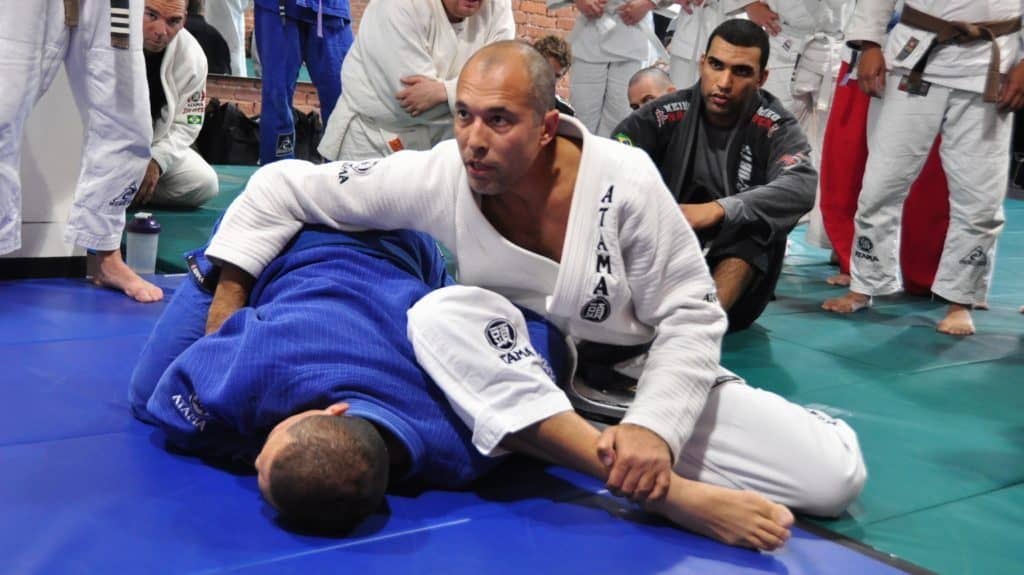The closed guard is the basis of BJJ. This is where everything started: the closed guard. Probably the first position you’ll learn in BJJ class, the closed guard is a versatile position that’ll give you opportunities to finish… if you know what you’re doing.
Top Vs. Bottom
The one thing that argues against the closed guard as being a good position is that your opponent is on top. This gives him a gravitational advantage. In a no-holds-barred match an opponent could rain punches down on you. However, the person utilizing the closed guard can do a lot to stop this and even finish. Trap the arms. Disrupt posture. You could argue in favor of the closed guard with the fact that you’ve got four limbs against two: two legs and two arms against an opponent’s two arms. Truth is, it’s still four against four. Opponent uses legs to stand up and use base to disrupt the position. If opponent traps arms and stands up you’ve got to take measures to counteract that. Any of the leg weaving guards will do: X, single X, De La Riva etc.
Closed Guard fundamentals
The thing that’s often left forgotten is grip fighting. This is the most important thing you have to do when you’re playing closed guard. Win the grip fight. Practitioners sometimes forget this because they’re fighting grips with their legs. Spider hooks are in fact a type of grip. It’s not your hands that do the pulling and off-balancing. It’s your hooks. Use the legs as if they were an extra pair of arms. That’s what gives you the advantage or rather mental advantage because many people are unaccustomed to fighting legs.
Bottom Line: Win the Grip Fight
Base Attacks: The Holy Trinity
The armbar, triangle and the omoplata is the fundamental combo of the closed guard. It’s also one of those things every serious Brazilian Jiu-Jitsu practitioner should drill every time they train, 15 minutes or so. Base your whole game on these techniques or use them to set something else up. Each of these is a complex technique in and of itself. After you’ve gone through the figuring out phase, or even if you haven’t, drill them every day.

Take the Back
The backtake is there whenever you’ve got contact with another body. Hug someone. Take their back J Jokes aside, the little man’s game i.e. taking the back is one facet of the multi-dimensional core of Brazilian Jiu-Jitsu.
A Principle for Taking the Back
You can always take the back. What’s stopping you are the hands. Get rid of the hands and you’ve got a way to your opponent’s neck. Always have this up your sleeve. Use an underhook. Take the back. Two one, arm drag; take the back.
Post a hand and sit up
If your hips don’t feel as mobile off your back, perhaps the sit-up will suit you better. We’re calling this a different series because you’re not really fighting off your back. The combos you’ll go from sit-up are the hip bump, kimura and guillotine.
Hip Bump, Kimura combo
The hip bump is a fundamental sweep that uses the same basic principles for sweeping that the scissor sweep or flower sweep do. Trap the arm that’s going to base. Control posture. It doesn’t demand the flexibility or shoulder rolls that armbars do. All you need is the butt scoot.
Missed the hip bump? Go for the kimura. You didn’t catch the post. Attack it with a kimura or if you’re feeling fancy, go for a triangle. The posting arm leaves the neck exposed. Grab a lat, climb a leg over shoulders. Shoot for triangle.

Conclusion
This article references many techniques. It’s not a detailed instructional. It might give you ideas to figure out your game. Pick one. Try. Sit-up, off-the-back or backtakes are there for you. Good luck and godspeed.
